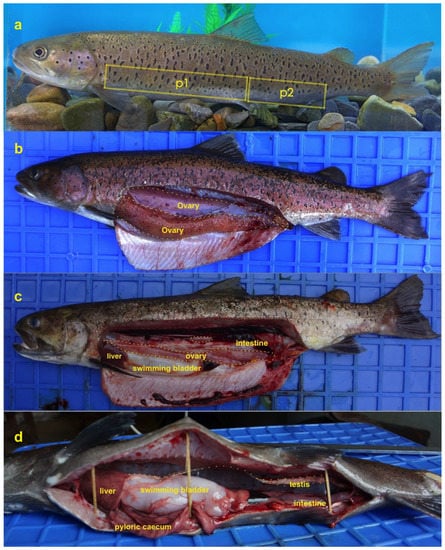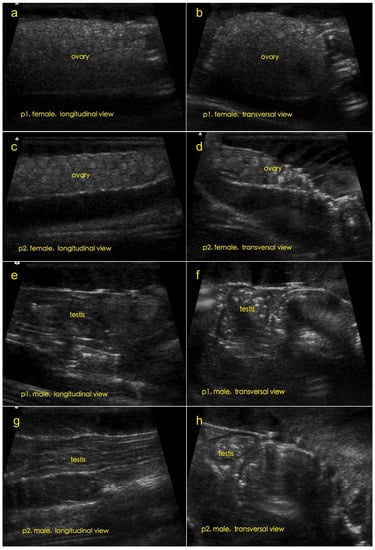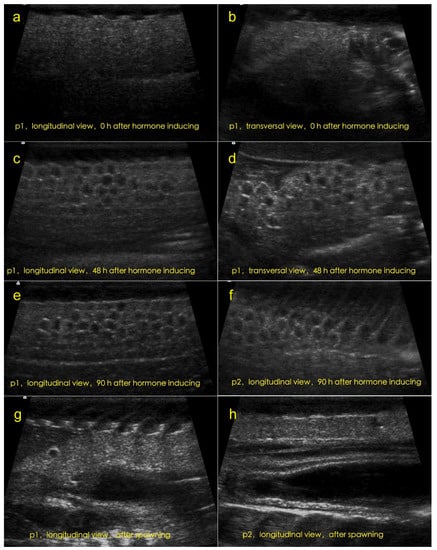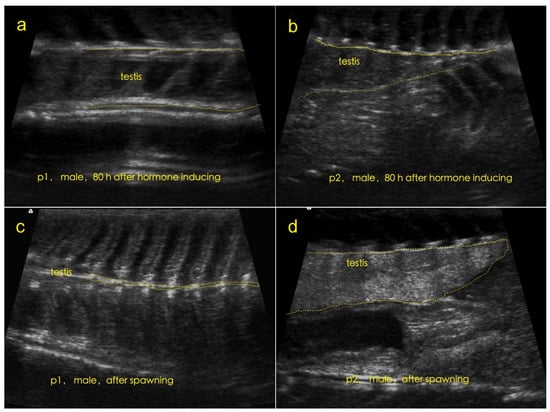Abstract
Sichuan taimen (Hucho bleekeri), a critically endangered species, is listed as a first-class protected species in China. The natural population has been missing from most of its known distribution areas for many years but was rediscovered in the Taibai River in 2012, providing an important resource for the conservation stocking of the Sichuan taimen. In this study, 43 wild adult Sichuan taimen collected from the Taibai River were determined for gamete maturity for artificial reproduction using ultrasonography. The echogenicity of the gonads before and after hormonal induction was described to determine broodstock identification, injection dose of hormones, and spawning time. Four batches of artificial breeding were successfully achieved in 2013, 2014, and 2016. Broodstock (19 females and 16 males) spawned with average fertilization and hatching rates reaching 80.2% and 61.0%, respectively. This study demonstrates that ultrasonic imaging is a convenient and efficient method to track the state of gonads of mature Sichuan taimen during artificial reproduction, which will assist in broodstock cultivation, and further large-scale proliferation and effective resource restoration of the Sichuan taimen.
Keywords:
Sichuan taimen; rescue and domestication; artificial reproduction; gonadal maturation; endangered species Key Contribution:
It is the first study to systematically investigate parental breeding, gonadal development monitoring, artificial fertilization, and fry breeding in Sichuan taimen using ultrasound imaging to identify mature gonads.
1. Introduction
Sichuan taimen (Hucho bleekeri Kimura), belonging to Salmoniformes, Salmonidae, and Hucho, is a unique, land-locked cold-water fish in China [1,2,3]. It is mainly distributed in the upper reaches of the Min River and Dadu River in Sichuan Province, the Taibai River and Xushui River, tributaries of the Hanjiang River in Shaanxi Province, and the Make River in Qinghai [1,4]. Sichuan taimen may be a remnant fish that invaded from the north to the south during the glacial period. This species has important academic value in different fields, such as zoogeography and paleoecology, and may help further reveal the relationship between fish system evolution and climate change [5,6]. In addition, Sichuan taimen is an important cold-water fish germplasm resource in China and has a huge market development potential in aquaculture [7,8].
Since the 1960s, due to environmental degradation, overfishing, and other impacts, the resource quantity of Sichuan taimen has sharply decreased and its distribution area has been shrinking. To date, there has been no trace of this species in most of its known distribution areas for many years [9,10,11]. Owing to its endangered status, Sichuan taimen has been listed as an extremely endangered species on the International Union for Conservation of Nature Red List and as a national first-class protected aquatic wildlife in 2021 [12]. However, due to the limitations of experimental materials, research on Sichuan taimen has mainly focused on the preliminary study of its biology, resource distribution, and habitat characteristics in the early years [3,13,14], as well as the genetic study of specimen samples [15,16,17,18]. Fortunately, several Sichuan taimen populations were rediscovered in the Taibai River, Shanxi Province, in 2012 [19]. Therefore, artificial domestication and reproduction using these limited resources is a positive strategy for conservation research on this species [20,21,22].
Identification of gonad maturity in broodstocks is a critical part of artificial reproduction in fish. The sex and gonad maturity of Salmonidae during the breeding period are mainly determined by examining the ventral shape and cloacal color or the ovulation by squeezing the belly of broodstocks [7,23]. These methods can increase the stress of artificial operation and easily lead to inaccurate judgment of spawning time, resulting in failure of artificial spawning or overmaturity of eggs, which greatly impedes the efficiency of artificial reproduction [24]. Therefore, a more convenient and efficient method for the accurate assessment of the gonad state is urgently needed for Sichuan taimen. In this study, a wild broodstock of Sichuan taimen collected from the Taibai River since 2012 were domesticated and bred in an artificial environment, and ultrasound images were captured to examine the gonadal echogenicity before and after hormonal induction for estimation gonadal maturity of broodstock, injection dose of hormones, and spawning time during artificial reproduction. This study provides important insights into the reproductive process of Sichuan taimen and the captive conservation of this endangered species.
2. Materials and Methods
2.1. Parent Fish Cultivation
In this study, a total of 23 wild females (average body weight: 0.93 ± 0.27 kg) and 20 wild male broodstocks (average body weight: 1.35 ± 0.43 kg) were collected from Taibai River and cultured in the conservation and domestication base of Sichuan taimen established by Yangtze Fisheries Research Institute, Chinese Academy of Fishery Sciences in Taibai, Shaanxi Province. Based on the conditions of the natural spawning ground, including a water temperature of 4.5–9 °C gentle water flow, sand and gravel substrate and clear water quality, all fish were maintained in a flow-through pond (8 m in length, 6 m in width, and 2–5 m in depth) with a pebble substrate and water flow rate of 0.4–0.7 m/s. Water samples were collected from the Taibai River. The annual water temperature and dissolved oxygen were 4.7–16.2 °C and 7.6–11.0 mg/L. Fish were fed Tenebrio molitor and trash fish at 2–6% body weight 1–3 times a day, adjusted according to seasonal temperature fluctuations. After the culture water temperature was stabilized to more than 4.5 °C from March to May every year, mature parent fish were identified and chosen for artificial spawning.
2.2. Ultrasound Imaging Procedures and Evaluation
Before identification, the Sichuan taimen specimen was anesthetized using MS-222 solution (concentration, 20 ppm) and held on a wet towel. An ultrasound scan was performed along the abdominal surface using a Terason T3000 portable ultrasonograph and a linear array broadband probe with 7.5 MHz center frequency and 4 cm scanning depth. The anterior area from the end of the pectoral fin to the dorsal fin below the lateral line (P1) and the posterior area from the end of the dorsal fin to the anal fin (P2) were scanned separately, and ultrasound images in longitudinal and transverse views were recorded for comparative analysis to determine the timing of induced spawning (Figure 1a). A few accidentally dead specimens were scanned and verified by dissection to precisely identify maturity stages (Figure 1b–d) [25].

Figure 1.
Ultrasound scanning areas and dissection views of Sichuan taimen Hucho bleekeri. (a) scanning areas; (b) prespawn female with stage IV ovary; (c) postspawn female with stage VI ovary; (d) postspawn male with stage II testis.
2.3. Artificial Spawning
The compounds S-GnRH-A (10 µg/kg) + domperidone (5 mg/kg) + VB2 (2 mg/kg) were prepared in 0.7% isotonic sodium chloride solution. The broodstocks were injected twice at an interval of 24 h, in which the male fish were injected with half the dose as that for the female fish. The fish were anesthetized with 20 ppm of the MS-222 solution in advance, wrapped with a wet towel, and injected intraperitoneally with 0.1–0.2 mL of the dose via the tail. After 48 h of injection, fish maturity was examined by ultrasound every 24 h.
2.4. Artificial Fertilization and Hatching
The dry method of artificial fertilization was performed, in which sperm and eggs were separately collected using abdominal pressure and fully mixed by stirring for 30–60 s. The eggs were stirred slightly after adding water, washed several times, and evenly spread onto hatching frames in an indoor pond for incubation. During incubation, the water flow rate was less than 0.1 m/s, the water temperature was 10.0–11.2 °C, dissolved oxygen was 9.8–10.5 mg/L, and bright light was avoided. The development of fertilized eggs was monitored regularly, and dead eggs and impurities were removed. The fertilization rate was calculated at the gastrula stage, and the hatching rate was calculated one day post-hatching.
2.5. Seedling Breeding
The hatched larvae were transferred to a round fiberglass basin (diameter, 2 m; depth, 0.45 m) and cultured in a micro flow-through system, with a culture density of 500–1000 ind./L and controlled water temperature and dissolved oxygen at 10.2–19.9 °C and 7.7–11.6 mg/L, respectively. The larvae were first fed with artificially hatched jointless larvae of brine shrimp 3–4 times a day, and artificial feed (Alle cold-water fish open bait; particle size, 0.2–0.3 mm) was gradually added 10 days post-hatching. The amount of feed was based on the satiety of the larvae. After feeding, residual bait and feces were removed.
3. Results
3.1. Ultrasonic Evaluation of Gonads
In this study, the shape, contour, and echogenicity were the main ultrasonographic characteristics used to determine the sex and gonadal maturity of the parent fish. In general, well-developed ovaries (stage III and later stage) presented a homogeneous appearance with bright reflections whereas the testes were usually dark and displayed well-defined lobules with distinct margins, especially in the transverse views (Figure 2). Ultrasound images of both scan areas became synchronously more recognizable because of the response of the ovaries to the induction of exogenous hormones. Vacuole-like structures appeared after 48 h (Figure 3c,d), and were augmented, well-distributed, and arranged after 90 h (Figure 3e,f), indicating that the ovary was fully developed for ovulation. After spawning, irregular hypoechogenicity was observed (Figure 3g,h).

Figure 2.
Ultrasound images of the gonads of mature Hucho bleekeri. Mature ovary (a–d) and testis (e–h) of p1 and p2 in both longitudinal and transversal views were shown.

Figure 3.
Ultrasound images of ovaries of mature Hucho bleekeri after hormonal induction. (a,b) 0 h after hormonal induction; (c,d) 48 h after hormonal induction; (e,f) 90 h after hormonal induction; (g,h) after spawning.
Ultrasound images from p1 and p2 views show the unsynchronized maturity state of the inducing testis (Figure 4). After 80 h of hormonal induction, the testes of p1 appeared as deeply dark regions (sperm), indicating that these testes were ready for spermiation, and then degenerated into a single line after spawning. However, the testes of p2 had no sperm and still could be imaged with comparative bright reflection after artificial spawning. These results were also validated by observation of dissected individuals (Figure 1d). Therefore, the linearly arranged oocytes and homogeneous dark structures in testis were the key characteristics for making decisions regarding the artificial collection of eggs and sperm.

Figure 4.
Ultrasound images of testes of mature Hucho bleekeri after hormonal induction. (a,b) 80 h after hormonal induction; (c,d) after spawning.
3.2. Artificial Reproduction
Artificial reproduction was successfully performed in domesticated wild Sichuan taimen in 2013, 2014, and 2016. As shown in Table 1, 19 females in 4 batches with an average body weight of 1.06 kg spawned. The effect time of the exogenous hormones was 48–108 h. The eggs were collected once by ventral compression, and a total of 25,329 eggs were obtained in four batches. The average egg-laying amount per female was 1333. Moreover, 16 males with an average body weight of 1.26 kg spawned, and 8.8 mL sperm were collected in total. The fertilization rate of eggs collected in different batches was not far different, ranging from 75.71% to 83.00%, and 20,442 fertilized eggs were obtained.

Table 1.
The results of artificial propagation in 2013, 2014, and 2016.
3.3. Hatching and Seedling Breeding
Under an incubation temperature of 10.0–11.2 °C, the fertilized eggs completed embryonic development after 549–586 h of incubation. The larvae began to hatch after 20 days, the hatching proportion peaked at 22 days, and all larvae hatched after 26 days. A total of 12,369 larvae in four batches were obtained with a full length of 11.62 ± 0.50 mm. Newly hatched larvae were fed brine shrimp as the opening bait. After one month of cultivation, the size of the fry reached 23.49 ± 0.09 mm, and its survival rate reached 98.89 ± 1.92%.
4. Discussion
Captive breeding is one of the positive strategies for endangered fish species recovery [26]. Under captive conditions, the regulation of ecological environmental factors plays an important role in fish growth, especially in the development and maturation of gonads [27]. However, research on artificial breeding in Sichuan taimen is still lacking. In the present study, based on the ecological needs of Sichuan taimen natural reproduction and artificial domestication conditions of other species of Salmonidae [23,28], especially Hucho [7,29], we developed environmental factors, such as water temperature and flow rate, and food regulation scheme and achieved the first successful development and maturation of gonads of captive Sichuan taimen.
The developmental quality and determination of the suitable period for gonads are essential for the breeding capability of broodstocks. Ultrasound has been used as a convenient and effective method to obtain identifiable information during the gonadal maturation of other fish species [30,31,32]. Similarly, in the present study, the presence and size of the vacuole-like structures were the key characteristics distinguishing the maturity of ovaries, and the appearance and intensity of the dark structures were the main characteristics distinguishing the maturity of the testes. Furthermore, ultrasound images present the state of gonads of mature individuals after hormonal induction, providing a basis for determining the right time to sample the oocyte and sperm or for adjusting the dose of the hormones [33].
Exogenous hormones substantially affect cold-water fish [26,34]; the type, dose, and injection interval of hormones are crucial for artificial spawning. A mixture of S-GnRH-A + domperidone is usually used in salmonoids [7,26]. In addition, vitamins have been used to enhance the physical fitness of induced fish [35,36]. In the present study, the induced spawning rate exceeded 70%, indicating that the artificial spawning program was effective for mature Sichuan taimen.
The hatching rate of embryos directly reflects the success of artificial reproduction. Embryonic development in fish is related to various environmental factors, such as water temperature, dissolved oxygen, light, and water quality [37]. Salmonids are cold-water fish with a long incubation period of more than 15 days [22,38]. Therefore, environmental control is particularly important for increasing the hatching rate. In the present study, light, water temperature, and dissolved oxygen were controlled in an ecological range. However, light was not the main influential factor found in our previous work [20], and the optimal ecological conditions for embryo development still require further study. In the present study, the water used was natural Taibai River water; therefore, suspended solids and impurities might have affected the normal metabolism of embryos to a certain extent, which may be attributed to the low hatching rate in 2014. These findings suggest that water should be strictly treated and disinfected during incubation and that the incubation density and microflow control of water are crucial for preventing the adhesion and hypoxia of fertilized eggs.
5. Conclusions
In summary, this study is the first to systematically investigate parental breeding, gonadal development monitoring, artificial fertilization, and fry breeding in Sichuan taimen using ultrasound imaging to identify mature gonads. We have successfully achieved artificial propagation of wild Sichuan taimen. Due to the limited resources, artificial propagation technology, such as the breeding of fry and the post-natal rehabilitation of parent fish, still needs further research. Regardless of these limitations, this study provides an important reference for further large-scale proliferation and effective resource restoration of Sichuan taimen.
Author Contributions
Conceptualization, methodology, investigation, resources and writing—original draft preparation, H.D., W.X. and J.W.; writing—review and editing and visualization, X.L., P.C. and J.L.; supervision, project administration, and funding acquisition, X.L. and J.W. All authors have read and agreed to the published version of the manuscript.
Funding
This research was funded by the National Key R&D Program of China (Grant No. 2021YFD1200304, 2021YFD1200305) and the National Natural Science Foundation of China (Grant No. 31602165).
Institutional Review Board Statement
The animal study protocol was approved by the Animal Experimental Ethical Committee of Laboratory Animal Centre, Yangtze River Fisheries Research Institute, Chinese Academy of Fishery Sciences. Approval code: yfilxq02.
Data Availability Statement
All data generated during this study are included in this published article.
Conflicts of Interest
The authors declare no conflict of interest.
References
- Ding, R.H. The Fishes of Sichuan, China; Sichuan Publishing House of Science and Technology: Chengdu, China, 1994; p. 641. [Google Scholar]
- Wu, W.R. Changes in the number of tiger sharks in the Daichuan river and their causes. Fish. Sci. Technol. Inf. 1988, 5, 3–6. (In Chinese) [Google Scholar]
- Zhou, Y.J.; Wu, W.R. A preliminary research for the conditions of spawning ground and the spawning habit of Hucho bleekeri kimura in the Da Chuan River. Chin. J. Fish. 1988, 1, 67–73. (In Chinese) [Google Scholar]
- Yue, P.Q.; Chen, Y.Y. China Red Data Book of Endangered Animals (Pisces); Science Press: Beijing, China, 1998. [Google Scholar]
- Ding, R.H.; Fang, J. Studies on conservation biology of Hucho bleekeri II. Data for characters and ecology. Sichuan J. Zool. 1995, 14, 6–19. (In Chinese) [Google Scholar]
- Song, Z. Hucho bleekeri. The IUCN Red List of Threatened Species; 2012; Version 2014. 3. Available online: https://www.iucnredlist.org/species/13151680/174797529 (accessed on 19 June 2012).
- Xu, W.; Sun, H.W.; Guan, H.H.; Kuang, Y.Y.; Lu, J.S.; Yin, J.S. Growth development and reproduction of reared Hucho taimen. J. Fish. Sci. China 2007, 14, 896–902. (In Chinese) [Google Scholar]
- Zhang, Y.Q.; Luan, P.X.; Ren, G.M.; Hu, G.; Yin, J.S. Estimating the inbreeding level and genetic relatedness in an isolated population of critically endangered Sichuan taimen (Hucho bleekeri) using genome-wide SNP markers. Ecol. Evol. 2020, 10, 1390–1400. [Google Scholar] [CrossRef]
- Ding, R.H.; Gui, L.H.; Li, M.; Luo, Q.H. Protective Biology of Hucho bleekeri in the Upper Changjiang River, China. J. Guangxi Norm. U. 2010, 28, 96–102. (In Chinese) [Google Scholar]
- Shen, Z.X.; Tang, W.J.; Li, K.M. The analysis of population dynamics of Hucho bleekeri in Markehe River, Qinghai Province. Reserv. Fish. 2006, 26, 71–73. (In Chinese) [Google Scholar]
- Yang, D.G.; Wei, Q.W.; Li, X.X.; Zhang, X.Q.; Cheng, B.L. The distributing actuality and protecting countermeasure of rare aquatic animals in Xushui River of Qinling Mountains. J. Fish. Sci. China 1999, 6, 123–125. (In Chinese) [Google Scholar]
- Hu, M.H.; Wang, Y.J.; Cao, L.; Xiong, B.X. Threatened fishes of the world: Hucho bleekeri Kimura, 1934 (Salmonidae). Environ. Biol. Fish. 2008, 82, 385–386. [Google Scholar] [CrossRef]
- Wu, W.R. Ecological niche of Hucho bleekeri Kimura and aquatic lifes in Dachuan River. Chin. J. Fish. 1989, 1, 23–33+3. (In Chinese) [Google Scholar]
- Zhou, Y.J.; Wu, W.R.; Yao, W.Z. A preliminary study on the biology of Hucho bleekeri kimura. J. Southwest Agric. U. 1994, 1, 72–75. (In Chinese) [Google Scholar]
- Qi, D.L.; Chao, Y.; Yang, C.; Shen, Z.X.; Tang, W.J. Cloning of Mitochondrial Cytochrome b Gene of Hucho bleekeri and its Phylogenetic Relationships in Subfamily Salmoninae. Sichuan J. Zool. 2009, 6, 805–809. (In Chinese) [Google Scholar]
- Wang, Y.; Guo, R.; Li, H.; Zhang, X.Y.; Du, J.; Song, Z.B. The complete mitochondrial genome of the Sichuan taimen (Hucho bleekeri): Repetitive sequences in the control region and phylogenetic implications for Salmonidae. Mar. Genom. 2011, 4, 221–228. [Google Scholar] [CrossRef] [PubMed]
- Wang, K.; Zhang, S.H.; Wang, D.Q.; Xin, M.M.; Wu, J.M.; Sun, Q.L.; Du, H.; Wang, C.Y.; Huang, J.; Wei, Q.W. Development of 27 novel cross-species microsatellite markers for the endangered Hucho bleekeri using next-generation sequencing technology. Conserv. Genet. Resour. 2015, 7, 263–267. [Google Scholar] [CrossRef]
- Wu, X.C. The Loss of Genetic Diversity in Sichuan Taimen as Revealed by DNA Fingerprinting. Biochem. Genet. 2006, 44, 177–185. [Google Scholar] [CrossRef]
- Du, H.; Li, L.X.; Wei, Q.W.; Zhang, S.H.; Wang, C.Y.; Sun, Q.L.; Yang, X.G.; Li, L. The rediscovery of Hucho bleekeri in the Taibai River, the upper tributary of the Han River, China. Chin. J. Zool. 2014, 3, 414. (In Chinese) [Google Scholar]
- Wang, C.Y.; Du, H.; Wu, J.M.; Cheng, W.W.; Yang, H.C.; Zhang, H.; Liu, Z.G.; Zhou, Q.; Wei, Q.W. Effect of illumination on the hatching of Sichuan Taimen (Hucho bleekeri Kimura) eggs. Freshw. Fish. 2019, 49, 62–65. (In Chinese) [Google Scholar]
- Wu, J.M.; Yang, H.C.; Wang, C.Y.; Du, H.; Wei, Q.W. Effect of initial feeding on the growth and survival of Sichuan Taimen (Hucho bleekeri) Larvae. Sichuan J. Zool. 2015, 34, 752–755. (In Chinese) [Google Scholar]
- Yang, H.C.; Yang, X.G.; Wu, J.M.; Wang, C.Y.; Wei, Q.W. Early development of Hucho bleekeri Kimura. J. Fish. Sci. China 2016, 23, 759–770. (In Chinese) [Google Scholar]
- Li, P.; Wang, F.; Wen, S.E. Study on parent fish cultivation and artificial propagation of Brachymystax lenok tsinlingensis. J. Shanghai Ocean U. 2015, 6, 841–846. (In Chinese) [Google Scholar]
- Swenson, E.A.; Rosenberger, A.E.; Howell, P.J. Validation of endoscopy for determination of maturity in small salmonids and sex of mature individuals. T. Am. Fish. Soc. 2007, 136, 994–998. [Google Scholar] [CrossRef]
- Liu, J. Reproductive Physiology of Cultured Fish in CHINA; China Agricultural Press: Beijing, China, 1993; pp. 20–73. [Google Scholar]
- Brown, C.; Day, R.L. The future of stock enhancements: Lessons for hatchery practice from conservation biology. Fish Fish. 2002, 3, 79–94. [Google Scholar] [CrossRef]
- Araki, H.; Ardren, W.R.; Olsen, E.; Cooper, B.; Blouin, M.S. Reproductive success of captive-bred steelhead trout in the wild: Evaluation of three hatchery programs in the Hood river. Conserv. Biol. 2007, 21, 181–190. [Google Scholar] [CrossRef] [PubMed]
- Chen, C.S.; Zheng, W.; Shi, X.; Guo, M.L.; Liu, N. Artificial Breeding of Brachymystax lenok in the Tumen River. J. Water Ecol. 2017, 38, 103–108. (In Chinese) [Google Scholar]
- Jungwirth, M. Ovulation inducement in prespawning adult Danube salmon (Hucho hucho, L.) by injection of acetone-dried carp pituitary (cP). Aquaculture 1979, 17, 129–135. [Google Scholar] [CrossRef]
- Hliwa, P.; Bah, M.; Kuzminski, H.; Dobosz, S.; Ciereszko, A. Ultrasound evaluation of the gonadal structure in sex-reversed rainbow trout females. Aquacult. Int. 2014, 22, 89–96. [Google Scholar] [CrossRef]
- Jennings, C.A.; Will, T.A.; Reinert, T.R. Efficacy of a high- and low-frequency Ultrasonic probe for measuring ovary volume and estimating fecundity of striped bass Morone saxatilis in the Savannah River Estuary. Fish. Res. 2005, 76, 445–453. [Google Scholar] [CrossRef]
- Robert, E.; Paul, S.W.; James, E.G. Use of Ultrasound Imaging to Determine Sex of Shovelnose Sturgeon. N. Am. J. Fish. Manag. 2004, 24, 322–326. [Google Scholar]
- Du, H.; Zhang, X.Y.; Leng, X.Q.; Zhang, S.H.; Luo, J.; Liu, Z.G.; Qiao, X.M.; Kynard, B.; Wei, Q.W. Gender and gonadal maturity stage identification of captive Chinese sturgeon, Acipenser sinensis, using ultrasound imagery and sex steroids. Gen. Comp. Endocrinol. 2017, 245, 36–43. [Google Scholar] [CrossRef]
- Jungwirth, M. Some notes to the farming and conservation of the Danube salmon (Hucho hucho). Environ. Biol. Fish. 1978, 3, 231–234. [Google Scholar] [CrossRef]
- Izquierdo, M.S.; Fernández-Palacios, H.; Tacon, A.G.J. Effect of broodstock nutrition on reproductive performance of fish. Aquaculture 2001, 197, 25–42. [Google Scholar] [CrossRef]
- Xiao, D.Y.; Liang, M.Q. Research Advances in Functions of Vitamins on Broodstock Nutrition. Chin. J. Anim. Nutr. 2012, 24, 2319–2325. (In Chinese) [Google Scholar]
- Wang, G.E. Fish early embryogenesis and its environmental factors. J. Northeast. Norm. U. 1988, 3, 115–131. (In Chinese) [Google Scholar]
- Shi, D.L.; Wei, Q.W.; Sun, Q.L.; Li, L.X.; Du, H. Early ontogenesis of Brachymystax lenok tsinlingensis. J. Fish. Sci. China 2012, 19, 557–567. (In Chinese) [Google Scholar] [CrossRef]
Disclaimer/Publisher’s Note: The statements, opinions and data contained in all publications are solely those of the individual author(s) and contributor(s) and not of MDPI and/or the editor(s). MDPI and/or the editor(s) disclaim responsibility for any injury to people or property resulting from any ideas, methods, instructions or products referred to in the content. |
© 2023 by the authors. Licensee MDPI, Basel, Switzerland. This article is an open access article distributed under the terms and conditions of the Creative Commons Attribution (CC BY) license (https://creativecommons.org/licenses/by/4.0/).